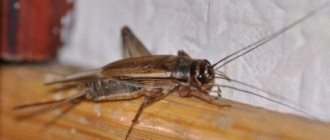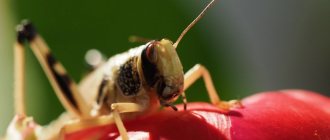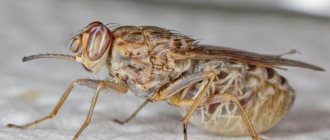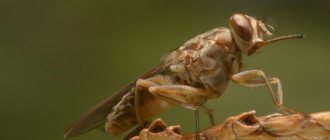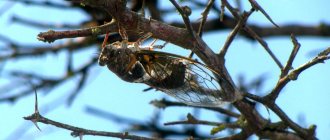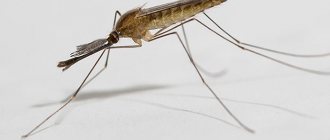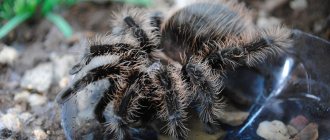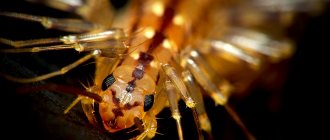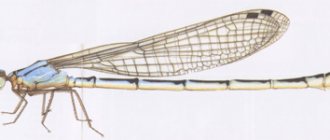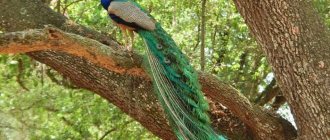When we hear about fireflies, we imagine fabulous and magical insects with a small lantern in their paws. Their light show is associated with warm summer evenings from childhood.
We invite you to immerse yourself in the wonderful world of these bugs and learn not only about what fireflies look like, but also how and why they glow.
Features and habitat of the firefly
At night, fireflies captivate people's views. But few people have seen what a firefly looks like during the day. This insect belongs to the Coleoptera beetles. Their varieties number more than 2000 species.
Fireflies during the day can be recognized by the following description of their appearance:
- The size of adult individuals can be from 4 mm to 3 cm.
- The body has an oblong and flat shape.
- The color can be brown, brown or black.
- The firefly has 4 wings on its body, two of which allow the beetle to fly, and the other two serve as elytra.
- A small head, covered by a pronotum, most of which is occupied by huge compound eyes.
- There are also two antennae on the forehead, which can have a thread-like, comb-like or saw-tooth shape. Each antenna consists of 11 segments.
- The oral apparatus is well developed only in the larvae and females of some species. In adult males it is often reduced, i.e. not intended for food.
- The main distinguishing feature of fireflies is their abdomen. It contains a unique luminous organ, which consists of reflectors filled with uric acid and photogenic cells. The oxidation process causes the characteristic glow.
During the daytime, fireflies can be confused with cockroaches, and females even look unattractive.
female firefly
Fireflies have highly developed sexual dimorphism, which means that males and females look completely different.
Males have external features characteristic of beetles and can fly. The female remains similar to her larvae and most often prefers to move on the ground, while in most species it is the females who emit a pleasant glow.
In Russia, the firefly family includes about 15 different species. For the most part, these beetles prefer tropical and subtropical climates, so the most common continents where fireflies live are:
- Australia and New Zealand
- Africa
- North and South America
Insects also live, but in smaller numbers, throughout Europe and Asia.
Appearance
Externally, the firefly insect looks very modest, even inconspicuous. The body is elongated and narrow, the head is very small, and the antennae are short. The size of the firefly insect is small - on average from 1 to 2 centimeters. The body color is brown, dark gray or black.
Many species of beetles have distinct differences between male and female. Male insect fireflies resemble cockroaches in appearance and can fly, but do not glow.
The female looks very similar to a larva or worm; she has no wings, so she leads a sedentary lifestyle. But the female knows how to glow, which attracts representatives of the opposite sex.
Character and lifestyle
These amazing bugs are mainly nocturnal. During the day they like to hide in the grass, and with the onset of darkness they begin to actively move and fly. At the same time of day, beetles form clusters of their relatives, despite the fact that during the day they try to stay apart.
It is also interesting that firefly larvae do not sit still, waiting to mature. They also prefer to move at night. Moreover, their travels are not limited to land; they can often be found under water.
During the onset of cold weather, all fireflies hide under the bark of trees. With the arrival of warm weather, the larvae pupate, and the adults are ready to mate.
Females of some firefly species often attack and eat males.
Interestingly, to attract the attention of a male of another species, the female changes the color of her glow. The male is attracted by the familiar color, but when he realizes that he has been deceived, he can no longer escape. The female attacks him and eats him.
Spreading
Fireflies are widespread in North America, Asia and Europe. They can be found in deciduous and tropical forests, in clearings, meadows and swamps. This is a representative of a large family from the order of beetles, which has the amazing ability to emit quite bright light.
The firefly is an insect belonging to the firefly family (Lampyridae), the order of Coleoptera. The family has over two thousand species. It is especially widely represented in the subtropics and tropics, and quite limited in the temperate zone. The countries of the former Soviet Union are home to seven genera and almost 20 species. And in our country, many people know what a firefly looks like. 15 species have been registered in Russia.
For example, nocturnal insects are Ivanovo worms, which spend the day in fallen leaves and thick grass, and at dusk they go hunting. These fireflies live in the forest, where they hunt small spiders, small insects and snails. The female cannot fly. It is completely colored brown-brown, only on the underside of the abdomen three segments are white. It is they who emit bright light.
Fireflies living in the Caucasus glow in flight. Sparkles dance in the thick darkness and give the southern night a special charm.
Why do fireflies glow?
Watching the wonderful flickering of living lights is amazing and interesting, but it’s even more interesting to know why fireflies glow.
Glow is used by fireflies for communication.
Some species are capable of blinking to conduct a dialogue with relatives. But mainly their lights light up to attract the attention of individuals of the opposite sex.
In some members of the firefly family, only males have a luminous organ, in others only in females, and in others, both sexes are capable of luminescence.
There are also types of fireflies that are not capable of glowing at all. Firefly larvae and eggs can also emit light, but they are not able to use it for its intended purpose.
The females of most species of fireflies do not have wings and cannot fly, so when you watch lanternflies flying, you will most often see males calling females to mate.
Nutrition
These insects can easily be classified as predators. Fireflies feed on a wide variety of animal foods. They love ants, spiders, the larvae of their fellows, snails and rotten plants.
Not all fireflies are predators. Among them there are also species that prefer pollen and nectar of plants. Species of fireflies in the adult phase, for example, do not eat anything at all; they have no mouth at all. Those fireflies that deceitfully lure representatives of other species to themselves and immediately eat them have chosen the most difficult method of obtaining food.
The scientific explanation for yellow-green beacons
The glow of fireflies is a complex chemical process.
The organs responsible for flickering are called laterns.
Anatomically, they consist of photogenic cells, trachea and nerve endings. Under the laterns there are light reflectors that are filled with uric acid crystals.
In order for a chemical reaction to occur and flying bugs to begin emitting light, photogenic cells must be filled with:
- oxygen
- luciferin (light-emitting substance)
- luciferase (oxidative enzyme)
- adenosine triphosphate (ATP)
The entire chemical reaction occurs due to oxygen entering the firefly’s body. The air passes through the beetle's trachea and enters the luminescent organ.
Luciferin is then oxidized, with luciferase accelerating the process and ATP acting as an energy source. After this reaction, the firefly's abdomen begins to glow.
Nerve endings allow the beetles to independently control the glow and regulate its brightness.
What kind of light do fireflies emit?
The color of the glow depends on the composition of the luciferase and may vary depending on the type of firefly.
Typically, light consists of shades of yellow and green spectrum. The wavelength is 500-600 nm.
The glowing beetle emits a cold light. An ordinary lamp heats up over time, releasing heat along with the light. At the same time, the efficiency of an artificial light source rarely exceeds 10%.
Fireflies convert up to 98% of expended energy into radiation.
By the frequency of flickering, as well as by hue, the firefly is able to distinguish its relatives from the same family.
Females of some species are able to change the shade of the glow, thus luring fireflies from another species to attack them.
Types of firefly light signals
Scientists distinguish several types of glows:
| Constant glow | Beetles cannot control this type of bioluminescence. Most often found in eggs or larvae |
| Changing the brightness of the glow | Depends on daily rhythms, depending on which the beetle is able to change the brightness of the glow or stop flickering altogether. |
| Ripple | The frequency of bursts and decays is regulated by circadian rhythms. |
| Flashes | Beetles flicker and fade spontaneously and without any temporal periodicity. |
| Synchronized glow | Some varieties of fireflies are able to simultaneously begin to glow and fade in a mass gathering. |
| Flicker | A series of short light signals that alternate one after another. This type of glow is characteristic of all types of fireflies. |
Synchronized flashing of fireflies
The most amazing type of glow is found in Lampyridae beetles that live in tropical forests. At night, they form mass clusters and begin to simultaneously light and extinguish their lights. The spectacle is truly mesmerizing and fabulous.
firefly forest
Scientists have not yet figured out how fireflies manage to glow synchronously, but they have some guesses about this.
There is a theory that in a mass gathering there is a main one - the “leader” of all beetles. He acts as a conductor, and the rest of the fireflies catch the rhythm of the glow and act synchronously.
Only males participate in such a concert. Scientists are still inclined to believe that such actions are aimed at attracting females.
Another interesting fact is that if you turn on a flashlight next to the synchronized dance of fireflies, the insects lose their rhythm. But after turning off the artificial light source, their actions again become synchronous.
Such unusual dances of fireflies were described back in 1680 by the German naturalist E. Kaempfer.
Today you can witness a natural light show by visiting Elcomont National Park in the USA.
Examples of photos with fireflies
Did you like the article? Share the post with your friends, write comments, subscribe to Twitter, Boosty and other pages to be the first to see all the most interesting things!Interesting facts about fireflies
- Thanks to fireflies, scientists were able to isolate the gene that is responsible for the emission of light. Subsequently, botanists introduced the gene into plants, which also began to glow.
- The brightest species of firefly lives in America. It has luminous organs not only in the abdomen, but also in the thoracic region. The light of this beetle is 150 times brighter than that of other relatives.
- In ancient times, people found use for fireflies in everyday life. A large number of individuals were placed in a jar and received a kind of lantern.
- You can't eat fireflies. In the cuisines of some countries, eating beetles is common. But fireflies are not suitable for this. When a beetle dies, a toxin enters its bloodstream, which can be dangerous to humans. In addition, the taste of this beetle is disgustingly bitter. By the way, animals know this and do not feed on this insect.
- In Japan there is a Firefly Festival. At the beginning of summer, people go out at night to special gardens and watch with admiration the accumulation of luminous beetles.
Lifestyle
Fireflies are not collective insects, but despite this they often form quite large clusters. Many of our readers have no idea what fireflies look like, since they are difficult to see during the day: they rest, sitting on plant stems or the ground, and at night they lead an active life.
Different types of fireflies also differ in their feeding habits. Herbivorous, harmless bugs feed on nectar and pollen. Predatory individuals attack spiders, ants, snails and centipedes. There are species whose adults do not feed at all, they do not even have a mouth.
Reproduction and lifespan
In June, fireflies become active and ready to reproduce.
Females use light to attract their partners. After mating (the process takes 1-3 hours), the females lay eggs in the ground. After some time, larvae emerge from them.
firefly larva
Externally, the larvae of most firefly species resemble worms. Many of them have a dark color and white spots on the lateral lines of the body. You can distinguish a firefly larva from other insects by its characteristic feature - glow.
All larvae are very voracious predators. Their diet consists of various small insects and spiders.
Until pupation, the larvae lead a mobile nocturnal lifestyle. They confidently move around the nearby territory in search of food, for which they are even ready to dive into water.
It takes up to two years for some individuals to mature. The pupation process of firefly larvae lasts on average 1.5-2 weeks.
Fireflies do not live long. On average, their lifespan is only 90-120 days.
A little romance or time for a date
By studying fireflies, entomologists have come to the conclusion that the main reason why bugs flicker in the dark is their desire to attract a potential mate. Each species has its own distinctive signals, exhibiting different light patterns. Thus, female fireflies, sitting on a leaf, send certain signals to male fireflies, which hover in the air and look for their “companion”.
Seeing a familiar light, they head straight towards it. Once nearby, the fireflies mate, and the female immediately lays fertilized eggs in the ground, from which larvae will later hatch, flat in shape and brown in color. Some larvae glow until they turn into beetles.
Small tricks of the female half
Attracting a potential mate is not the only reason why fireflies use their gift for bioluminescence. Some species of flickering beetles can produce light for completely opposite purposes.
For example, fireflies belonging to the Photuris species are able to exactly copy the signals of fireflies of another species. Thus, females deceive gullible male strangers.
When they fly up in the hope of mating, Photuris females devour them and receive enough nutrients for themselves and the larvae of their species ready to hatch from the ground.
Koalas are the original representatives of the living world of Australia101854.811
Firefly communication systems
Fireflies communicate using their glow. Surprisingly, luminescent signals allow beetles to demonstrate the full range of their emotions. They are able to express desire or refusal to mate, warn relatives of danger, and use light for hunting or protection.
The degree of diversity in communication signals depends on the species of firefly. For example, in the family Lampyridae there are two main types of communication:
- Calling signal Females attract individuals of the opposite sex with their glow, signaling their readiness to mate. In this case, males may have no luminous organs at all.
- Dialogue Most often, males take the initiative to communicate. They begin to emit signals calling on the female to answer whether she is ready to mate. In response, representatives of the opposite sex respond with either consent or refusal.
Some European species of fireflies have a more advanced communication system using glow, for example, Luciola italica and Luciola mingrelica.
Luciola italica
The benefits and harms of fireflies
The firefly is a harmless insect, and on the contrary, very useful.
Predatory families actively fight parasites, such as flatworms, and are also capable of destroying slugs.
Fireflies are highly valued in science. Thanks to their study, scientists were able not only to solve the mystery of all insects capable of glowing, but also to derive a gene that contributes to this.
In addition, special substances are isolated from fireflies that help determine whether there is life on a particular planet.
Fireflies practically do not participate in the food chain as prey. Their toxic substances are dangerous to animals.
Unconventional use of natural lanterns
Looking at the bright flickering of fireflies, since ancient times people have wondered why not use them for useful purposes. The Indians attached them to moccasins to illuminate paths and scare away snakes. The first settlers to South America used these bugs as lighting for their huts. In some settlements this tradition has been preserved to this day.
In the modern world, the question of why and how fireflies acquired the ability to bioluminescence, and how their gift can be used for scientific purposes, excites the mind of more than one entomologist. Scientists, through extensive trial and error, even managed to find a gene that causes the cells of these insects to produce luciferase.
Once this gene was isolated, it was transplanted into a tobacco leaf and the seeds were sown in an entire plantation. The emerging crop glowed when darkness fell. Experiments with fireflies are not over yet: a lot of new and interesting discoveries await us.
Some members of the family
Let us remember that there are more than 2000 species of fireflies, and it is simply impossible to consider them in one article. Therefore, we suggest that you familiarize yourself with some varieties of fireflies.
Large firefly (common firefly or firefly, lat. Lampyris noctiluca)
The beetles received the name “Ivan’s worm” from the holiday of Ivan Kupala. It is at this time, at the beginning of summer, that the mating season of fireflies begins and people can watch a fabulous light show.
The size of the beetle varies from 1.1 cm to 1.8 cm. Females are usually larger than males and are completely different from them. The appearance of the female resembles a larva, while the appearance of the male is fully consistent with the standard description of luminescent beetles.
Regardless of gender, all individuals of this type of firefly have a luminous organ. However, males emit a very weak light, which is difficult to notice; on the contrary, the glow of females is very bright.
Only male fireweeds have wings and the ability to fly; females are inactive and move on the ground.
Pennsylvania firefly (lat. Photuris pennsylvanica)
The beetles live only in Canada and the USA. This type of firefly is quite large, their size reaches 2 cm.
The males of this species have a black colored shell. The elytra are yellow and the eyes are red. Females have a worm-like appearance.
These fireflies are interesting because the female can imitate the glow of representatives of the Photinus species. In this way they attract the attention of males in order to attack and eat them.
Water firefly (lat. Luciola cruciata)
An interesting species of luminous beetles that prefer to live in bodies of water. Most often they can be found on rice plantations in Japan. Individuals use their glow not only to attract individuals of the opposite sex, but also for hunting. The beetles feed mainly on mollusks and fluke worms.
Fire photinus (lat. Photinus pyralis)
The most popular species of fireflies found in North America. These beetles are very useful for science, since American scientists isolate luciferase from individuals of this genus. The enzyme is subsequently used for scientific experiments.
Male photinus use light mimicry only when taking off and fly in a zigzag-like trajectory. Females of this species are able to imitate the signals of other firefly species to hunt males.
Choosing a partner
Matriarchy reigns among fireflies - the female chooses a partner. It is determined by the intensity of the glow. The brighter the light, the higher the frequency of its flickering, the more likely the male is to charm the female. In tropical forests, during collective “serenades”, trees shrouded in such necklaces shine brighter than shop windows in big cities.
Cases of mating games with fatal outcomes have also been recorded. The female, using a light sign, attracts males of another species. When the unsuspecting fertilizers appear, the insidious temptress eats them.
After fertilization, larvae emerge from the eggs laid by the female. What do firefly larvae look like? Quite large, voracious, black-colored worms with clearly visible yellow spots. Interestingly, they glow, just like adults. Closer to autumn, they hide in the bark of trees, where they spend the winter.
The larvae develop slowly: in species living in the middle zone, the larvae overwinter, and in most subtropical species they grow for several weeks. The pupal stage lasts up to 2.5 weeks. The following spring, the larvae pupate and new adults develop from them.
